MyPortugalHoliday.com
The best independent guide to Madeira
MyPortugalHoliday.com
The best independent guide to Madeira
Madeira top 10 sights, activities and things to do in 2026
Madeira is a varied and fascinating holiday destination offering numerous unique sights and activities.
This is an island of jagged mountains, dense forests and traditional Portuguese villages, which will entertain visitors of all ages. Many visitors come to simply relax by the pool and embrace the pleasant climate, but there is so much more to see and do.
This article will provide a guide to the top 10 activities and the top 10 sights of Madeira, to inspire you to visit the island and get the most from your holiday!
Note: We have tried to include a range of sights and activities suitable for all ages. The first section (top 10 activities) are more designed if you want an active holiday, while the second section (top 10 sights and towns) are more if you prefer a sightseeing and touring holiday.
Related articles: Introduction to Madeira – 1 week in Madeira
Top 10 activities of Madeira
10) The scenic coastal drive between São Vicente and Porto Moniz
Madeira is full of spectacular mountain roads, but one of the most scenic drives is along the coast between São Vicente and Porto Moniz. This route follows the massive cliffs and steep river valleys of the northern coastline, where small villages perch and water gushes down the cliffs into the sea.
The road originally twisted along the side of the cliffs but now is much safer with the constriction of the VE2. Sadly, this new road has many long tunnels, but there are multiple places to stop and admire the dramatic scenery. The route ends in the pretty town of Porto Moniz with its lava swimming pools.
Related articles: Porto Moniz guide
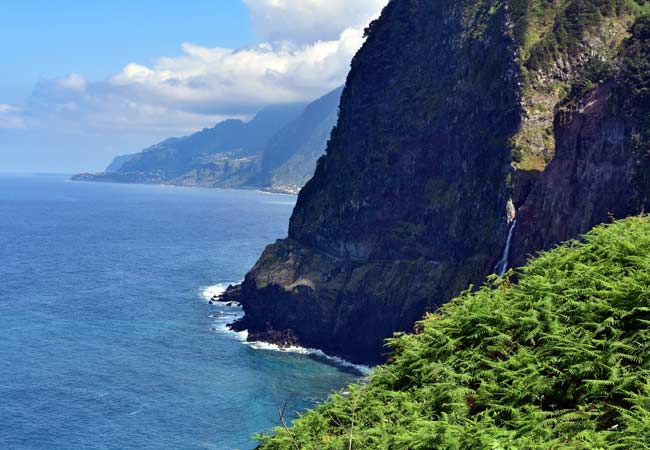
The rugged coastline close to Porto Moniz
9) Carreiros sledge ride in Monte
The wicker sledge ride down Monte hill may be touristy, but it represents one of Madeira's most authentic historical traditions adapted for modern visitors. This unique transport method has genuine roots in local necessity, making it far more than mere gimmickry.
The tradition began in the 1850s when local workers needed an efficient way to transport goods from Monte's elevated position down to Funchal's markets below. The wicker sledges, known as Carreiros after their drivers, provided a practical solution for navigating steep cobblestone streets that were treacherous for wheeled vehicles. By the 1910s, wealthy visitors staying in Monte's grand hotels began using the sledges as thrilling transport back to the city.
Today's experience remains remarkably authentic. Two skilled carreiros in traditional white cotton uniforms and straw boater hats guide each sledge using only their rubber-soled boots for steering and braking. The 2-kilometer descent covers 200 meters of elevation through narrow residential streets, requiring genuine skill to navigate safely around parked cars and pedestrians.
The ride takes about 10 minutes and costs around 30 euros for two people. Start early (before 10 AM) to avoid crowds and longer waits. The experience ends at Livramento, from where you can catch a taxi back to central Funchal or continue exploring the historic neighborhoods on foot.
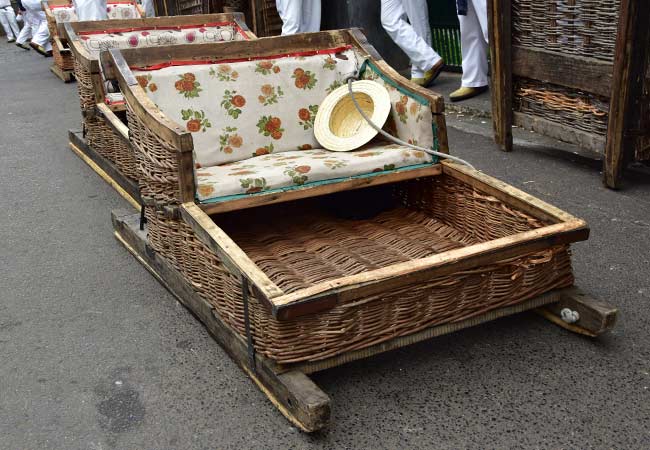
The wicker sledges that slide down the roads
8) The Cabo Girão Skywalk
Standing on the glass-floored Cabo Girão Skywalk tests nerves in the most spectacular way possible. At 580 meters above the Atlantic Ocean, these sea cliffs rank among Europe's highest, and the transparent platform extends boldly over the precipice to provide unobstructed views straight down to the waves below.
Below the cliffs, you can spot the famous fajãs: small agricultural plots carved from narrow coastal ledges where local farmers still grow vegetables and vines using cable car systems to transport produce up and down the cliff face. These remarkable terraces represent centuries of agricultural ingenuity and provide fascinating context for understanding how Madeirans have adapted to their dramatic landscape.
Related articles: The Cabo Girão Skywalk
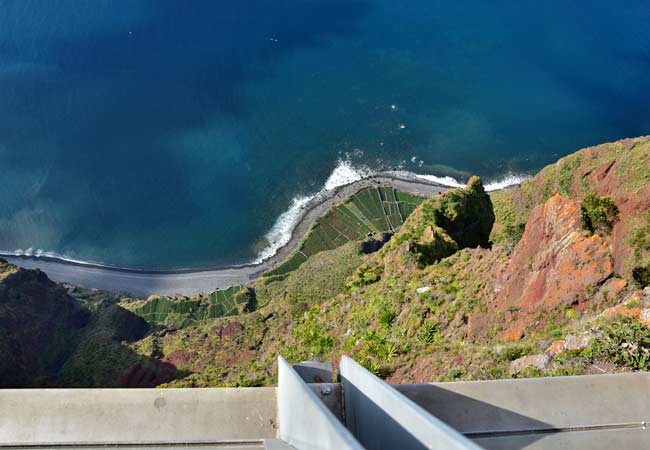
It is 580m drop to the sea below
7) Climb to Pico Ruivo the highest point of the Madeira
Pico Ruivo is the highest point of Madeira, and from the 1,862m summit are spectacular views over the jagged and dramatic mountain landscapes.
There is a scenic mountain trail to Pico Ruivo from Achada do Teixeira which follows the PR1.2 hiking route (2-3 hours return) and crosses high ridges to scale the northern side of the mountain.
There is an even more stunning hiking trail (and more challenging) the PR1, and this is at number 1 in our list of the top 10 activities.
Related articles: Pico Ruivo

The final steps up to the summit of Pico Ruivo
6) Drink a Poncha with some locals in a bar
Experiencing authentic Madeiran culture means stepping into a neighborhood taberna where locals gather for their daily dose of Poncha, the island's beloved traditional spirit.
Poncha combines aguardente de cana (sugar cane rum), fresh lemon juice, and honey in proportions that vary by family recipe and personal preference. The drink originated in Câmara de Lobos fishing village, where it provided warmth and calories for fishermen facing cold Atlantic mornings. Today, variations include maracujá (passion fruit), tangerina (tangerine), or even exotic fruits like tamarillo.
Seek out authentic tabernas rather than tourist bars. Try Taberna Real in Funchal's old town, where elderly locals gather each afternoon for cards and conversation. In Câmara de Lobos, visit the small bars around the harbor where fishermen still start their day with Poncha and grilled limpets. Taberna do Ruel offers the most traditional experience, complete with hand-painted tiles and a proprietor who has been mixing Poncha for over 40 years.
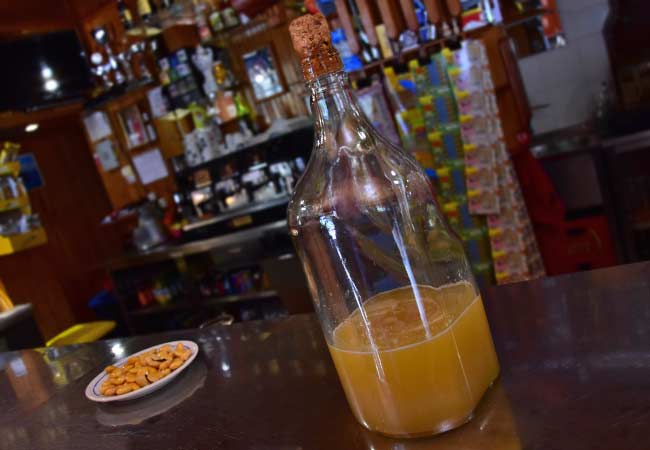
A bottle of Poncha ready to make the bar jolly…
5) Hike along PR6 and the Risco waterfall
Madeira is a walkers paradise, with many beautiful hiking trails which cross the island. Many of these trails follow the man-made waterways (known as Levadas) that transported water from the wet northern side of Madeira to the drier and more fertile south.
One of the most interesting routes is the PR6, which snakes around the Rabaçal valley, with its many little streams, dense forests and numerous waterfalls. The highlight will be the 100m Risco waterfall, as water rushes off the high plateau on the Paul da Serra. This abundance of water, streams and waterfalls gives the hike its name, the 25 Fontes (the 25 Springs).
The start of the hike is at the Miradouro do Rabaçal, which offers great views over the lush Laurel forests.

The PR6 follows a Levada waterway as it meanders along the Rabaçal valley
4) Sunrise at Pico do Arieiro
The Pico do Arieiro (1,818m) is the third highest point in Madeira and is one of the finest locations to watch the sunrise. On the eastern side of the Arieiro is the Miradouro do Juncal viewpoint, with amazing views over the east of Madeira and the rising sun - so long as there is no cloud!
There is a decent road up to Pico do Arieiro, and is relatively safe to drive pre-dawn light.
Advice: The viewpoint is often shrouded in cloud or fog so always check the weather before departing, and always bring a coat as it will be cold and windy.
Related articles: Pico do Arieiro
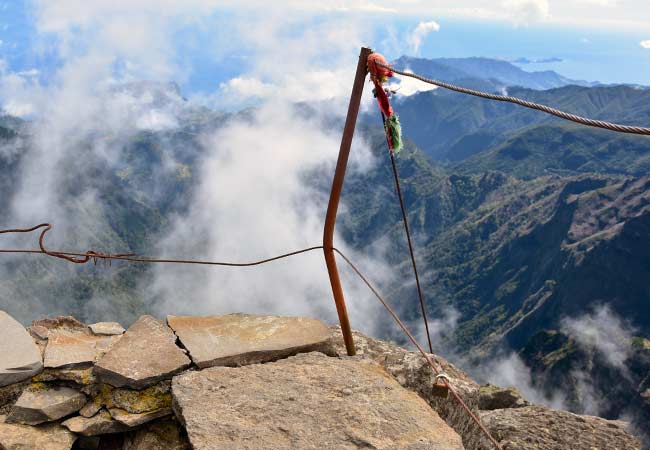
The view from the Miradouro do Juncal
3) Join a whale or dolphin watching boat tour
The deep, warm and nutrient-rich waters of the Atlantic Ocean around Madeira are popular feeding and migrating routes for whales and dolphins.
Pilot and Sperm Whales are found all year in the waters around Madeira along with Bottlenose dolphins, while whale migration tends to be May to June and September to October. Dolphins are much more frequently seen than whales.
There are many tours on offer around Madeira, but typical prices are €25 for a 3-hour catamaran tour or €45 for a two-hour speed boat tour.
Advice: The seas around Madeira can be rough, only book a tour on a calm day and if you are not prone to seasickness.

Two whales on the south coastline of Madeira
2) Go canyoning
Madeira is regarded as one of the world's best destinations for canyoning as there are many deep river valleys offering waterfalls, cliffs, plunge pools and huge rocks.
During the guided canyoning experience expect to scramble down a river by climbing, swimming, abseiling, jumping and generally getting wet.
There are extremely difficult routes on the north side of the island, but most visitors follow the easy or moderate routes along Ribeira das Cales river (in Parque Ecológico do Funchal), the Ribeiro Frio (in Parque Natural do Ribeiro Frio) or the Ribeira do Lajeado.
Canyoning is always a fun experience while in Madeira, especially in the hot summer months. Prices vary but expect to pay €60 for 3 hours

1) Mountain hike from Pico do Arieiro to Pico Ruivo
The RP1 hiking trail (called the Vereda do Arieiro) is the best mountain hiking route in Madeira. This is a challenging 5-hour (15km) round trip, which includes stunning sections. There are high mount ridges with near vertical drops, paths that scale the side of cliffs and an endpoint of the Pico Ruivo, the highest point of Madeira.
The PR1 is a tough round trip; as going there is a very demanding 20-minute stair section to climb, and the return route is all uphill.
Warning: As this is a long hike in the mountains always be suitably prepared and check weather conditions before attempting the route.
Insight: This hike can be done as a tour, which provides transport and knowledgeable guide, for only €38.50
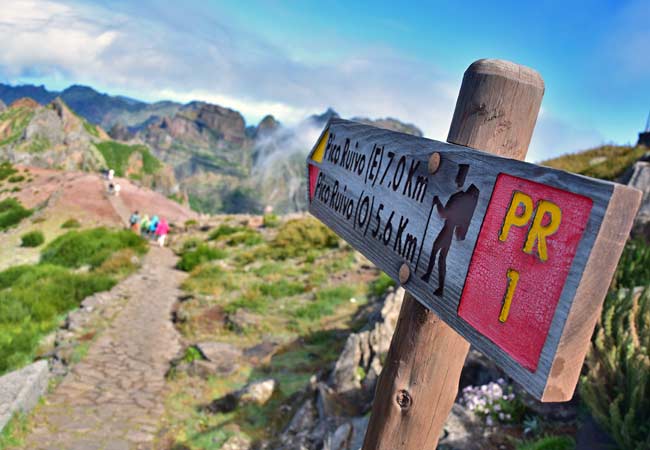
PR1 route as is climbs through the mountains
Top 10 sights and places to visit in Madeira
10) The abandoned village of Calhau das Achadas
Reaching Calhau das Achadas feels like discovering a secret that Madeira tried to keep hidden. This remote hamlet on the wild western tip tells a poignant story of isolation, survival, and the changing face of rural Madeira that extends far beyond its dramatic cliff-top setting.
Until 2003, this tiny farming community was completely cut off from the modern world, accessible only by treacherous boat journeys or grueling cliff-face climbs. Families here lived as their ancestors had for centuries: growing potatoes and corn in terraced plots carved from the clifftops, raising goats, and living entirely off the land and sea.
The Achadas da Cruz cable car, one of Europe's steepest, now provides a thrilling 5-minute descent down 436 meters of sheer cliff face. The real magic happens when you explore the abandoned stone houses and agricultural terraces that cascade down toward the crashing Atlantic. Many structures remain intact, offering haunting glimpses into a way of life that persisted into the 21st century.

Riding the cable car down to Calhau das Achadas
9) Santana
Santana offers far more than the iconic triangular houses featured on every Madeira brochure, though these traditional structures remain undeniably charming. This northern coastal town provides a fascinating glimpse into traditional Madeiran rural life that most tourists rush past without properly exploring.
The famous casas de colmo (thatched houses) with their steep A-frame roofs were not built for photographs but represent ingenious adaptations to harsh mountain weather. The thick thatch sheds heavy rainfall while the steep pitch prevents snow accumulation. While only a handful of the original hundreds remain, the six preserved houses near the town center are meticulously maintained.
Beyond the postcard appeal, Santana offers excellent hiking access to the Queimadas Forest Park, where the PR9 Levada do Caldeirão Verde trail begins. The town also serves exceptional regional dishes. Try the black scabbard fish with banana at Quinta do Furão restaurant, which offers panoramic ocean views that rival any on the island.
Visit on a Sunday morning when locals gather at the small market selling homemade honey, traditional bolo de mel (honey cake), and embroidered linens.
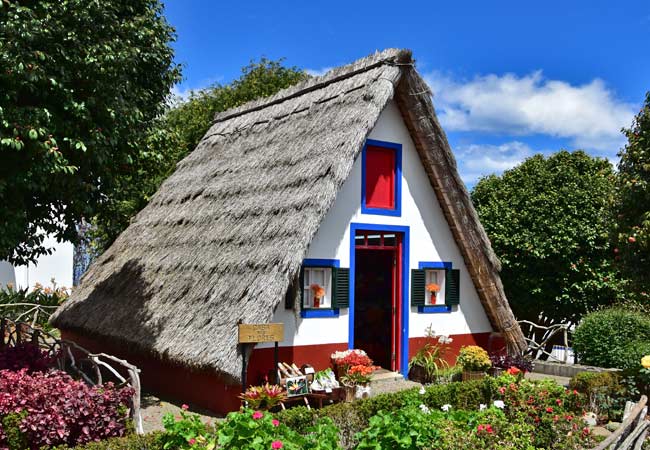
The population of Madeira used to live in houses similar to this one, with its steep roof to keep the harsh winter weather out
8) Ponta de São Lourenço headland
Stepping onto the Ponta de São Lourenço feels like landing on another planet: a stark, windswept peninsula that could not be more different from the lush interior of Madeira. This 8-kilometer finger of land stretching into the Atlantic represents the volcanic origins of the island in their purest form, where relentless trade winds have sculpted a landscape of stunning geological drama.
The unique microclimate of the headland creates a semi-arid environment supporting rare endemic plants found nowhere else on earth. During spring (March-May), the seemingly barren landscape explodes with colorful wildflowers including the endemic Madeira viper's bugloss and coastal ice plants that paint the cliffs in brilliant purples and yellows.
The PR8 walking trail to Ponta do Furado demands respect. Bring plenty of water and sun protection, and check weather conditions as exposed sections can be dangerous in high winds. The reward is spectacular: towering basalt pillars rising from churning seas, hidden coves accessible only by foot, and views across to the Desertas Islands that feel utterly primordial.
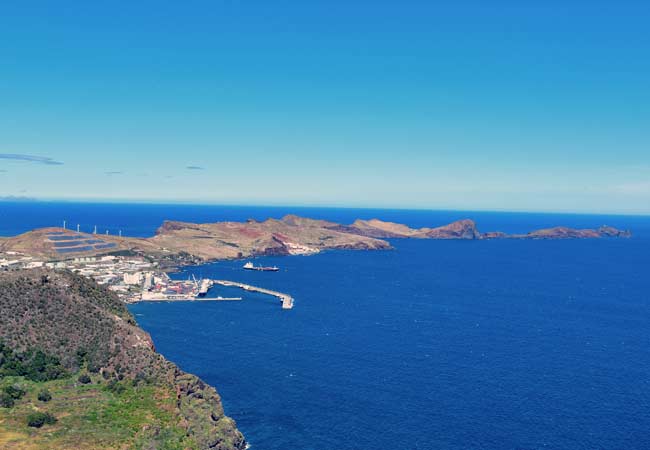
The Ponta de São Lourenço headland as seen from the Pico do Facho viewpoint
7) Câmara de Lobos
Câmara de Lobos is a colourful fishing town, made famous by Winston Churchill, who spent many of his later years painting here.
The harbour area and town centre are picturesque, with fishing boats moored on to the harbour beach and cobbled streets lining the town. During the day, the lively bars that surround the harbour are filled with fishermen drinking Poncha, a strong alcoholic drink that originated from the town.
Note: The pretty appearance of Câmara de Lobos does mask the tough fishing lifestyle of many of its residents, and the deprivation found on the outskirts of the town.
Insight: Câmara de Lobos is at the base of the Cabo Girão cliffs and the two are often combined in a trip.
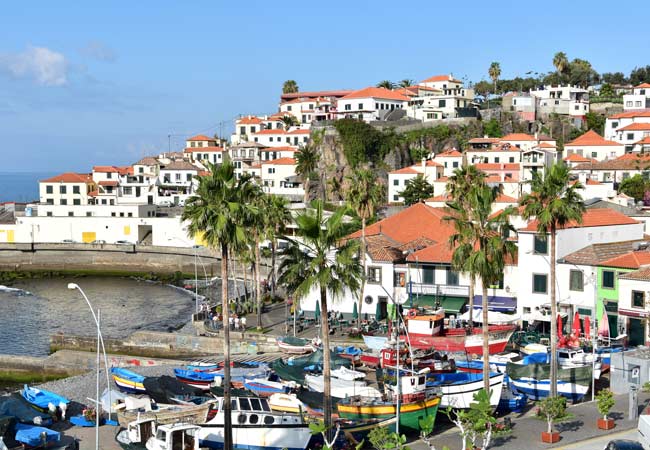
The colourful fishing boats of the difficult and dangerous livelihood
6) Ribeiro Frio Valley
The Ribeiro Frio river flows from the steep mountains of the interior of Madeira, and this deep river valley is covered by ancient Laurel forests.
These Laurissilva forests, with their rich biodiversity unique to Madeira, are classified as a UNESCO World Heritage site and are protected by the Parque Natural do Ribeiro Frio.
The Ribeiro Frio Valley is a popular area for walking, and one of the best routes follows the PR11- the Vereda dos Balcões. This trail leads to the Miradouro dos Balcões viewpoint, with its panoramic views over the Laurel forests and the Ruivo mountain.
Along the Ribeiro Frio, named so because of the freezing mountain water, is a large government-run trout farm, where you can see tanks full of fish.
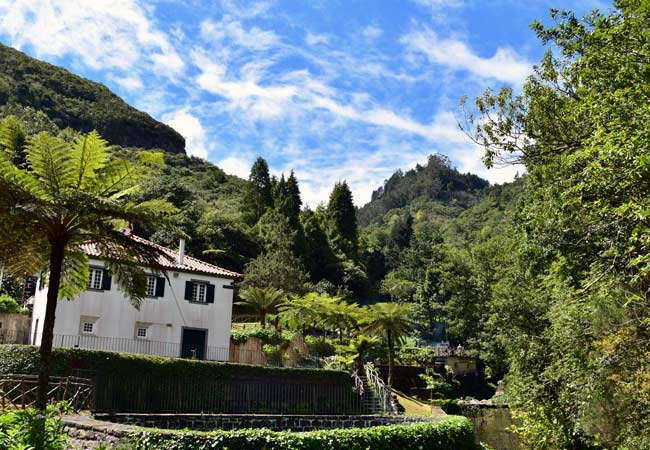
The lush Ribeiro Frio valley
5) Curral das Freiras
Curral das Freiras sits at the bottom of a deep valley, surrounded on all sides by steep mountains. This secluded location in the centre of the island was used by the nuns for the Santa Clara convent to hide during pirate raids in the 16th and 17th centuries.
The town later prospered with the cultivation of Sweet Chestnuts, which grow in the forest that surrounds Curral das Freiras.
The main tourist attraction of Curral das Freiras is the setting of the town, and the Eira do Serrado viewpoint provides the finest views.

Curral das Freiras nestles at the base of huge mountains
4) Porto Moniz
Sitting on the far north-western side of the island, Porto Moniz is famed for its lava swimming pools and remote setting.
Historically the town was geographically isolated from the rest of Madeira by huge cliffs, and was a centre for whaling (which continued until the 1980s).
This is wild a rugged region of Madeira, with the town squeezing between the giant cliffs and the ocean. The lava which once spilled from Madeira's volcanoes has formed jagged pools along the seafront and these are a popular location for swimming.
Porto Moniz sadly lacks the historic buildings as with other coastal towns……
Related articles: Porto Moniz
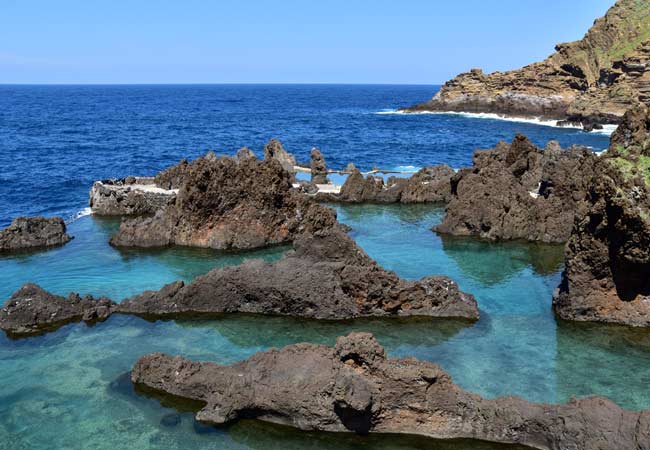
The lava pools of Porto Moniz are filled by the high tide
3) Ribeira Brava
Ribeira Brava is a likeable coastal town situated at the end of the Serra de Água valley. During the winter months, water rushes down this valley and gives Ribeira Brava its name (Angry River).
Ribeira Brava has a pleasant beachfront promenade along the pebble beach, a modern lido complex which is popular with families and the pretty Igreja de São Bento church. The town centre contains cobbled streets and whitewashed houses, and Ribeira Brava is regarded as the prettiest town in Madeira.
If you are seeking a calm and personable destination for your holiday (or day trip), then Ribeira Brava is the place to visit.
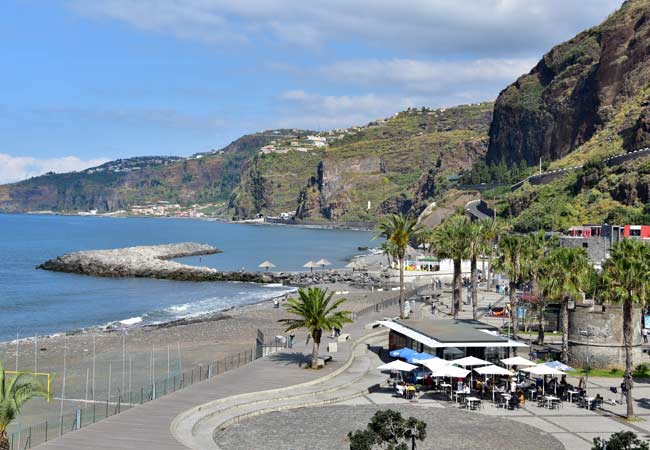
The pretty beachfront of Ribeira Brava
2) Monte
Monte is a pretty hillside town sits high above Funchal.
The slightly wetter and damp micro-climate of Monet is a fantastic area for growing, and found in the town are three outstanding gardens, along the beautiful Nossa Senhora do Monte church.
Monte is connected to Funchal by a cable car (Teleférico Funchal-Monte) which glides over the entire city Funchal. For the return, the wicker Carreiros sledges (no.9 activity) will provide you an exhilarating downhill slide back to the city.
The three gardens in Monte are the Monte Palace Tropical Gardens (exotic plants species), the Parque Leite Monteiro, which surround the Quinta do Monte Hotel, and the Jardim do Monte just behind the Nossa Senhora do Monte church.
Note: The most famous garden of Funchal, the Jardim Botânico da Madeira is not technically in Monte but is accessed by the Teleférico do Jardim Botânico cable car, which has a station in Monte, and is often included in a visit to the town.

The Monte Palace Tropical Gardens, with its many water features, statues, and exotic plants
1) Funchal
Funchal is the largest city of Madeira, and offers a delightful historic centre, a pretty harbourfront and a vast selection of restaurants, bars and shops. The city is surrounded by hills and forms a natural amphitheatre, with every district leading down to the waterfront and the historic centre.
There is a lot to see in Funchal, and a visit could include the Se cathedral, the São Tiago fort, the Praça do Município plaza and the Convento de Santa Clara. For museums, there is the Museu da Quinta das Cruzes, the Casa Museu Frederico de Freitas and the CR7 Museu, dedicated to Madeira’s most famous sportsman, Cristiano Ronaldo.
On a summers day, there is no more pleasant walk than along the water's edge from the harbour around to the Tiago fort.
While on holiday in Madeira you must devote at least one day to explore the charming historic centre of Funchal.
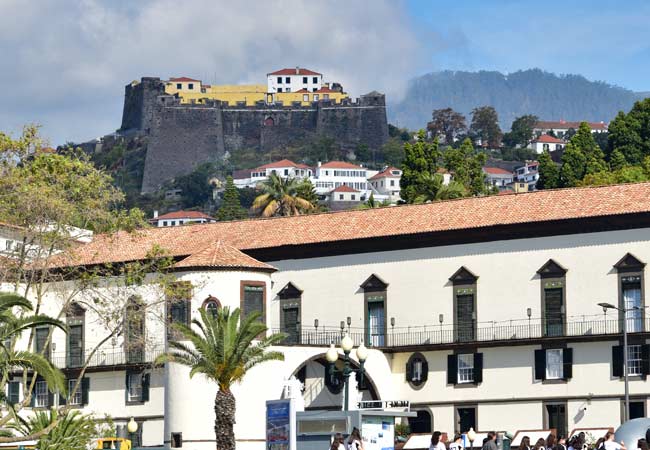
Looking up from Funchal waterfront up to the Fortaleza de São João Baptista
















